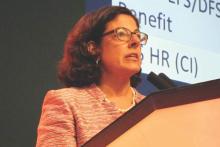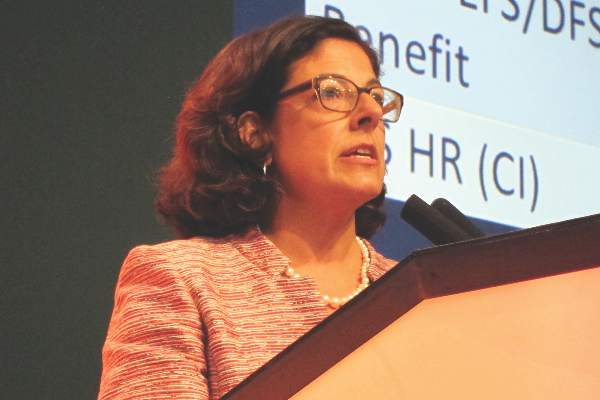User login
SAN ANTONIO – Should carboplatin be considered a routine part of neoadjuvant therapy in early stage triple negative breast cancer?
Not yet, Dr. Angela M. DeMichele declared at the San Antonio Breast Cancer Symposium.
“I would say it’s still an individualized decision. The hazard ratios suggest benefit, but currently there’s not enough data to be conclusive,” according to Dr. DeMichele, who served as discussant for two clinical trials with discordant results – GeparSixto and CALGB/Alliance 40603 – presented at the symposium.
She also addressed a second issue raised by the two studies: is a pathologic complete response a valid surrogate for event-free survival?
“I would say a qualified yes,” commented Dr. DeMichele, professor of medicine and epidemiology at the University of Pennsylvania, Philadelphia.
In GeparSixto, the addition of weekly carboplatin to a neoadjuvant chemotherapy backbone comprised of an anthracycline, taxane, and bevacizumab in patients with triple negative breast cancer (TNBC) boosted the 3-year disease-free survival rate significantly, from 76.1% to 85.5%. This result prompted GeparSixto presenter Dr. Gunter von Minckwitz, president of the German Breast Group, to declare that the study supports incorporation of carboplatin as part of standard neoadjuvant therapy in TNBC.
In contrast, in CALGB/Alliance 40603, adding carboplatin to neoadjuvant chemotherapy didn’t result in a significant improvement in 3-year event-free or overall survival.
Dr. DeMichele noted that with just 3 years of followup to date in these trials, there isn’t any information yet about carboplatin’s added potential long-term bone marrow toxicity. That’s an important unanswered question. Nor is any quality of life data available from the two trials. These issues need clarification before broader use of carboplatin.
One possible explanation for the disparate results in the two studies lies in differences in the chemotherapy and carboplatin doses and treatment schedules used. Patients in GeparSixto received greater cumulative amounts of anthracycline and taxane, given over a longer time period. And if patients were randomized to receive carboplatin, they got it at area under the curve 1.5 or 2 weekly for the duration of chemotherapy, as compared to carboplatin dosed just four times at area under the curve 6 every 3 weeks in CALGB/Alliance 40603.
“Could the weekly carboplatin in GeparSixto have provided less time for DNA repair in the tumor?,” she speculated.
Dr. William M. Sikov, who presented the CALGB/Alliance 40603 findings, found this quite plausible.
“We know treatment schedule and dose are important with anthracyclines, they’re important with taxanes, and it’s certainly not far fetched to propose that they may be important for carboplatin as well. Might that have made a difference? Can’t say,” observed Dr. Sikov of Women and Infants Hospital of Rhode Island in Providence.
In any case, Dr. DeMichele said neither GeparSixto, with its 315 patients with TNBC, nor CALGB/Alliance 40603, with 443, was adequately powered to prove or disprove a therapeutic advantage for the addition of neoadjuvant carboplatin.
“This is the 50th anniversary of the discovery of carboplatin. Yet despite all of our advancements in breast cancer, we’re still trying to figure out the role of platinum-containing agents in our armamentarium for breast cancer,” she observed.
During this period of what she termed clinical equipoise regarding carboplatin, she said it’s reasonable to consider using the agent outside of a clinical trial in selected circumstances: namely, when it’s important to gain rapid control of locoregional disease in order to improve operability or reduce morbidity, or in patients at the highest risk of relapse, mainly those who are very young or have stage III disease.
The issue of the validity of pathologic complete response (pCR) as a surrogate endpoint for event-free survival was raised by the GeparSixto and CALGB/Alliance 40603 investigators. In CALGB/Alliance 40603 only 9% of patients who had a pCR developed a distant recurrence and 3-year mortality was just 6%, compared with a 27% distant recurrence rate and 25% mortality in those without a pCR. Patients with a pCR had a 70% improvement in event-free survival and an 80% improvement in overall survival compared to those without a pCR, Dr. Sikov reported.
Similarly, in GeparSixto disease relapse occurred in only 5 of 129 TNBC patients with a pCR, compared with 50 of 162 without a pCR.
Dr. DeMichele said that while these are encouraging results, neither trial was designed to evaluate pCR as a predictor of improved event-free survival in accord with the Food and Drug Administration’s formal written guidance for attaining recognition of pCR as a surrogate endpoint. The studies were underpowered for this purpose. And a pooled analysis of 12 international trials totaling nearly 12,000 patients that was led by FDA investigators concluded that the data couldn’t validate pCR as a surrogate endpoint for event-free and overall survival (Lancet. 2014 Jul 12;384[9938]:164-72).
However, four studies adequately powered to detect improvement in event-free survival in conjunction with a carboplatin-induced benefit in terms of pCR are underway, including the NRG-BR-003 trial in the U.S. and the BrighTNess study in China.
In addition, a study with an innovative post-neoadjuvant design for platinum-based therapy is underway. The ECOG-ACRIN 1131 study is a Phase III randomized postoperative trial of four rounds of carboplatin or cisplatin versus observation in patients with residual TNBC following an anthracycline-based neoadjuvant regimen. This strategy limits exposure to the toxicities of platinum-based compounds to those patients in need of additional therapy. The planned 558-patient trial is powered to detect a 33% improvement in event-free survival.
SAN ANTONIO – Should carboplatin be considered a routine part of neoadjuvant therapy in early stage triple negative breast cancer?
Not yet, Dr. Angela M. DeMichele declared at the San Antonio Breast Cancer Symposium.
“I would say it’s still an individualized decision. The hazard ratios suggest benefit, but currently there’s not enough data to be conclusive,” according to Dr. DeMichele, who served as discussant for two clinical trials with discordant results – GeparSixto and CALGB/Alliance 40603 – presented at the symposium.
She also addressed a second issue raised by the two studies: is a pathologic complete response a valid surrogate for event-free survival?
“I would say a qualified yes,” commented Dr. DeMichele, professor of medicine and epidemiology at the University of Pennsylvania, Philadelphia.
In GeparSixto, the addition of weekly carboplatin to a neoadjuvant chemotherapy backbone comprised of an anthracycline, taxane, and bevacizumab in patients with triple negative breast cancer (TNBC) boosted the 3-year disease-free survival rate significantly, from 76.1% to 85.5%. This result prompted GeparSixto presenter Dr. Gunter von Minckwitz, president of the German Breast Group, to declare that the study supports incorporation of carboplatin as part of standard neoadjuvant therapy in TNBC.
In contrast, in CALGB/Alliance 40603, adding carboplatin to neoadjuvant chemotherapy didn’t result in a significant improvement in 3-year event-free or overall survival.
Dr. DeMichele noted that with just 3 years of followup to date in these trials, there isn’t any information yet about carboplatin’s added potential long-term bone marrow toxicity. That’s an important unanswered question. Nor is any quality of life data available from the two trials. These issues need clarification before broader use of carboplatin.
One possible explanation for the disparate results in the two studies lies in differences in the chemotherapy and carboplatin doses and treatment schedules used. Patients in GeparSixto received greater cumulative amounts of anthracycline and taxane, given over a longer time period. And if patients were randomized to receive carboplatin, they got it at area under the curve 1.5 or 2 weekly for the duration of chemotherapy, as compared to carboplatin dosed just four times at area under the curve 6 every 3 weeks in CALGB/Alliance 40603.
“Could the weekly carboplatin in GeparSixto have provided less time for DNA repair in the tumor?,” she speculated.
Dr. William M. Sikov, who presented the CALGB/Alliance 40603 findings, found this quite plausible.
“We know treatment schedule and dose are important with anthracyclines, they’re important with taxanes, and it’s certainly not far fetched to propose that they may be important for carboplatin as well. Might that have made a difference? Can’t say,” observed Dr. Sikov of Women and Infants Hospital of Rhode Island in Providence.
In any case, Dr. DeMichele said neither GeparSixto, with its 315 patients with TNBC, nor CALGB/Alliance 40603, with 443, was adequately powered to prove or disprove a therapeutic advantage for the addition of neoadjuvant carboplatin.
“This is the 50th anniversary of the discovery of carboplatin. Yet despite all of our advancements in breast cancer, we’re still trying to figure out the role of platinum-containing agents in our armamentarium for breast cancer,” she observed.
During this period of what she termed clinical equipoise regarding carboplatin, she said it’s reasonable to consider using the agent outside of a clinical trial in selected circumstances: namely, when it’s important to gain rapid control of locoregional disease in order to improve operability or reduce morbidity, or in patients at the highest risk of relapse, mainly those who are very young or have stage III disease.
The issue of the validity of pathologic complete response (pCR) as a surrogate endpoint for event-free survival was raised by the GeparSixto and CALGB/Alliance 40603 investigators. In CALGB/Alliance 40603 only 9% of patients who had a pCR developed a distant recurrence and 3-year mortality was just 6%, compared with a 27% distant recurrence rate and 25% mortality in those without a pCR. Patients with a pCR had a 70% improvement in event-free survival and an 80% improvement in overall survival compared to those without a pCR, Dr. Sikov reported.
Similarly, in GeparSixto disease relapse occurred in only 5 of 129 TNBC patients with a pCR, compared with 50 of 162 without a pCR.
Dr. DeMichele said that while these are encouraging results, neither trial was designed to evaluate pCR as a predictor of improved event-free survival in accord with the Food and Drug Administration’s formal written guidance for attaining recognition of pCR as a surrogate endpoint. The studies were underpowered for this purpose. And a pooled analysis of 12 international trials totaling nearly 12,000 patients that was led by FDA investigators concluded that the data couldn’t validate pCR as a surrogate endpoint for event-free and overall survival (Lancet. 2014 Jul 12;384[9938]:164-72).
However, four studies adequately powered to detect improvement in event-free survival in conjunction with a carboplatin-induced benefit in terms of pCR are underway, including the NRG-BR-003 trial in the U.S. and the BrighTNess study in China.
In addition, a study with an innovative post-neoadjuvant design for platinum-based therapy is underway. The ECOG-ACRIN 1131 study is a Phase III randomized postoperative trial of four rounds of carboplatin or cisplatin versus observation in patients with residual TNBC following an anthracycline-based neoadjuvant regimen. This strategy limits exposure to the toxicities of platinum-based compounds to those patients in need of additional therapy. The planned 558-patient trial is powered to detect a 33% improvement in event-free survival.
SAN ANTONIO – Should carboplatin be considered a routine part of neoadjuvant therapy in early stage triple negative breast cancer?
Not yet, Dr. Angela M. DeMichele declared at the San Antonio Breast Cancer Symposium.
“I would say it’s still an individualized decision. The hazard ratios suggest benefit, but currently there’s not enough data to be conclusive,” according to Dr. DeMichele, who served as discussant for two clinical trials with discordant results – GeparSixto and CALGB/Alliance 40603 – presented at the symposium.
She also addressed a second issue raised by the two studies: is a pathologic complete response a valid surrogate for event-free survival?
“I would say a qualified yes,” commented Dr. DeMichele, professor of medicine and epidemiology at the University of Pennsylvania, Philadelphia.
In GeparSixto, the addition of weekly carboplatin to a neoadjuvant chemotherapy backbone comprised of an anthracycline, taxane, and bevacizumab in patients with triple negative breast cancer (TNBC) boosted the 3-year disease-free survival rate significantly, from 76.1% to 85.5%. This result prompted GeparSixto presenter Dr. Gunter von Minckwitz, president of the German Breast Group, to declare that the study supports incorporation of carboplatin as part of standard neoadjuvant therapy in TNBC.
In contrast, in CALGB/Alliance 40603, adding carboplatin to neoadjuvant chemotherapy didn’t result in a significant improvement in 3-year event-free or overall survival.
Dr. DeMichele noted that with just 3 years of followup to date in these trials, there isn’t any information yet about carboplatin’s added potential long-term bone marrow toxicity. That’s an important unanswered question. Nor is any quality of life data available from the two trials. These issues need clarification before broader use of carboplatin.
One possible explanation for the disparate results in the two studies lies in differences in the chemotherapy and carboplatin doses and treatment schedules used. Patients in GeparSixto received greater cumulative amounts of anthracycline and taxane, given over a longer time period. And if patients were randomized to receive carboplatin, they got it at area under the curve 1.5 or 2 weekly for the duration of chemotherapy, as compared to carboplatin dosed just four times at area under the curve 6 every 3 weeks in CALGB/Alliance 40603.
“Could the weekly carboplatin in GeparSixto have provided less time for DNA repair in the tumor?,” she speculated.
Dr. William M. Sikov, who presented the CALGB/Alliance 40603 findings, found this quite plausible.
“We know treatment schedule and dose are important with anthracyclines, they’re important with taxanes, and it’s certainly not far fetched to propose that they may be important for carboplatin as well. Might that have made a difference? Can’t say,” observed Dr. Sikov of Women and Infants Hospital of Rhode Island in Providence.
In any case, Dr. DeMichele said neither GeparSixto, with its 315 patients with TNBC, nor CALGB/Alliance 40603, with 443, was adequately powered to prove or disprove a therapeutic advantage for the addition of neoadjuvant carboplatin.
“This is the 50th anniversary of the discovery of carboplatin. Yet despite all of our advancements in breast cancer, we’re still trying to figure out the role of platinum-containing agents in our armamentarium for breast cancer,” she observed.
During this period of what she termed clinical equipoise regarding carboplatin, she said it’s reasonable to consider using the agent outside of a clinical trial in selected circumstances: namely, when it’s important to gain rapid control of locoregional disease in order to improve operability or reduce morbidity, or in patients at the highest risk of relapse, mainly those who are very young or have stage III disease.
The issue of the validity of pathologic complete response (pCR) as a surrogate endpoint for event-free survival was raised by the GeparSixto and CALGB/Alliance 40603 investigators. In CALGB/Alliance 40603 only 9% of patients who had a pCR developed a distant recurrence and 3-year mortality was just 6%, compared with a 27% distant recurrence rate and 25% mortality in those without a pCR. Patients with a pCR had a 70% improvement in event-free survival and an 80% improvement in overall survival compared to those without a pCR, Dr. Sikov reported.
Similarly, in GeparSixto disease relapse occurred in only 5 of 129 TNBC patients with a pCR, compared with 50 of 162 without a pCR.
Dr. DeMichele said that while these are encouraging results, neither trial was designed to evaluate pCR as a predictor of improved event-free survival in accord with the Food and Drug Administration’s formal written guidance for attaining recognition of pCR as a surrogate endpoint. The studies were underpowered for this purpose. And a pooled analysis of 12 international trials totaling nearly 12,000 patients that was led by FDA investigators concluded that the data couldn’t validate pCR as a surrogate endpoint for event-free and overall survival (Lancet. 2014 Jul 12;384[9938]:164-72).
However, four studies adequately powered to detect improvement in event-free survival in conjunction with a carboplatin-induced benefit in terms of pCR are underway, including the NRG-BR-003 trial in the U.S. and the BrighTNess study in China.
In addition, a study with an innovative post-neoadjuvant design for platinum-based therapy is underway. The ECOG-ACRIN 1131 study is a Phase III randomized postoperative trial of four rounds of carboplatin or cisplatin versus observation in patients with residual TNBC following an anthracycline-based neoadjuvant regimen. This strategy limits exposure to the toxicities of platinum-based compounds to those patients in need of additional therapy. The planned 558-patient trial is powered to detect a 33% improvement in event-free survival.
EXPERT ANALYSIS FROM SABCS 2015


